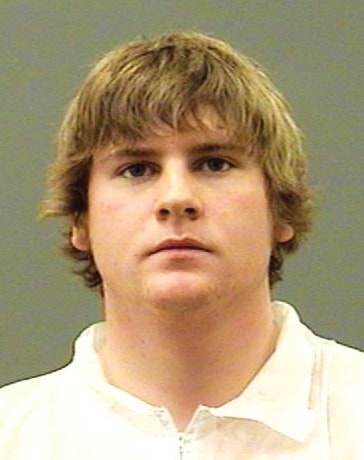An expert in bloodstain analysis who testified Wednesday in the Crown’s case was put to a rigorous cross examination Thursday by Cody Alan Legebokoff’s defence lawyer, James Heller.
Legebokoff, 24, is charged with first degree murder in the deaths of 15-year old Loren Leslie and three area women: Jill Stuchenko, Natasha Montgomery and Cynthia Maas. On Thursday, Crown prosecutor Joseph Temple told the court the Crown’s presentation of their evidence is now complete but added that their case was not officially closed. As well, Thursday, the 14-person jury in the case was released for three weeks.
Heller questioned Sgt. Beverly Zaporozan about the conclusions contained in reports she’d prepared in the case, several times posing to her other possible scenarios or explanations for bloodstains she’d found and analysed.
The bloodstains included ones found in snow and on a tree branch leading to a path where the dead body of Leslie was found. She agreed with Heller her work has much to do with “common sense”, however B.C. Supreme Court Justice Glen reminded him that Zaporozan was found to be an expert in a scientific field.
However, Heller returned again and again to the suggestion this (bloodstain analysis) is not a perfect science.
During his questions, he referred to the officer’s scientific findings with respect to bloodstains found in Legebokoff’s vehicle, a runner panel and back seat, as well as clothing items such as on his socks, shoes, shirt and shorts. He questioned her at length about her findings with respect to a number of other bloodstains including blood spatter and blood transfer evidence and DNA evidence found at Legebokoff’s Liard Drive apartment and Carney Street rental home.
Zaporozan agreed with Heller that in most instances she could not tell the “chronology” of the bloodstains, that is, when they were laid down nor could she determine the force or even the circumstances under which the bloodstain patterns were created. She also agreed with Heller that here were a number of possible explanations for the blood being there.
Heller referred the witness to an instance in which she put the maximum height of an arc-shaped stain on a hallway wall in the apartment at a higher number (59 centimetres) than that of a colleague. Zaporozan admitted this is an inconsistency between findings. When asked by Heller if she ever talked with the other analyst about that difference, she said no.
During his cross-examination, Heller pressed her several times about her conclusions. For example he questioned her specifically about a bloodstain ultimately linked to Stuchenko which was found on a couch.
The couch had been moved, she said, because a blood “icicle” found on the underneath part would be expected to also be present underneath it when the forensic team did its investigation.
There is no way of knowing, suggested Heller, how long Stucheno was on the couch or when that occurred.
“She could have bled significantly ….and left the couch alive or dead?” he asked.
“Possibly, yes,” said Zaporazan.
Heller also pointed to the runner or outside panel of Legebokoff’s vehicle which had blood spatter stains on it.
“So here too,” he said, “blood could have been deposited there at any time?” Zaporozan agreed that was true.
Her testimony in chief was heard Wednesday.
She provided jurors and the court with a general introduction to the field of bloodstain analysis, gave a PowerPoint presentation on bloodstain pattern analysis, and testified about her specific findings in the case against Legebokoff.
Bloodstain patterns are predictable and they are able to be reproduced (in a laboratory or other scientific setting) Zaporozan explained.
Questioned by Temple, she identified several photographs taken by RCMP investigators Nov. 28, 2010 of bloodstains found in the snow, and of their corresponding yellow markers, near the site off Highway 27 north of Vanderhoof where Leslie’s body was found soon after her death by a conservation officer.
Snow melts, she noted, explaining that because of that, she had no way of determining sufficient characteristics or properties of the blood to say for sure how they were deposited. Some areas where other bloodstains were found appeared to have been “disturbed,” she agreed. She also identified “transfer” bloodstains found on a tree limb.
Zaporozan was asked about her forensic analysis of exhibits seized and photographed in the Legebokoff case including his shoes. The left shoe had transfer stains on the shoelace and back of the heel, she said.
A DNA profile found that it matched with Leslie as a “major component.”
Another bloodstain on the heel of the right shoe, a “mixed origin” DNA profile, again had Leslie as its major component. Other blood stains found near the emblem and collar area of Legebokoff’s shirt had a similar result with a match to Leslie’s blood. Splatter stains on the leg area of shorts apparently worn by Legebokoff and transfer stains found by the pocket area as well as on the inside and outside surface of the shorts were also linked to Leslie.
Transfer bloodstains found on the back of the shorts in the buttocks area was found to be of mixed origin with the major component matched to Montgomery.
She also identified for the Crown some photographs relating to the forensic analysis of bloodstained items seized from Legebokoff’s vehicle such as a white sock, a jacket and parts taken from the vehicle itself, and a panel and grey seat back with blood transfer stains on four areas near the top. She found that those bloodstains were a match to Leslie.
